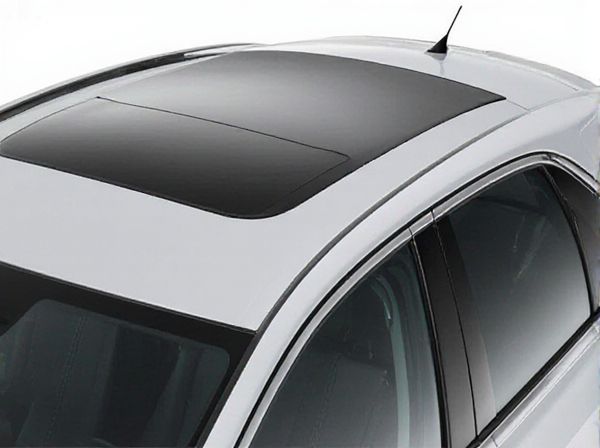
Photo illustration: Panoramic Roof vs Standard Roof
A panoramic roof offers expansive glass panels that enhance natural light and provide breathtaking views, creating an open and airy atmosphere inside your vehicle. Standard roofs typically feature solid materials that prioritize durability and insulation, ensuring better protection from weather and noise. Choosing between the two depends on your preference for aesthetics and the driving experience versus traditional functionality and comfort.
Table of Comparison
| Feature | Panoramic Roof | Standard Roof |
|---|---|---|
| Design | Large glass panel covering most of the roof | Opaque metal or composite roof |
| Natural Light | High, enhances cabin brightness | Minimal, relies on windows |
| Ventilation | Often equipped with tilt and slide options | Limited to windows and sunroofs |
| Weight | Heavier due to glass and frame | Lighter, standard materials |
| Cost | Higher initial and repair costs | Lower cost, easier maintenance |
| Visibility | Panoramic outside view | Traditional view limited to windows |
| Insulation | Depends on glass quality; may reduce thermal insulation | Better thermal and noise insulation |
Overview: Panoramic Roof vs Standard Roof
A panoramic roof offers a large glass panel extending over the front and rear seats, providing expansive natural light and a more open, airy cabin experience compared to a standard roof, which typically consists of a solid metal or smaller sunroof panel. Panoramic roofs enhance vehicle aesthetics and passenger comfort but may add weight and slightly reduce headroom, while standard roofs ensure better insulation and structural integrity. Choosing between panoramic and standard roofs depends on preferences for visibility, cabin ambiance, and potential trade-offs in energy efficiency and maintenance.
Key Features of Panoramic Roofs
Panoramic roofs feature expansive glass panels that enhance natural light and provide unobstructed views, significantly elevating the in-car experience compared to standard roofs. These roofs often incorporate UV protection and acoustic insulation, improving comfort while maintaining temperature control. Enhanced ventilation and the option to open sections allow for increased airflow, distinguishing panoramic roofs as premium, luxury additions in modern vehicles.
Standard Roofs: Main Characteristics
Standard roofs feature traditional construction with a solid, opaque design that provides superior insulation and weather protection compared to panoramic roofs. They are typically made from materials such as metal, asphalt shingles, or tiles, ensuring durability and lower maintenance costs. Standard roofs offer enhanced structural integrity and a quieter cabin environment by minimizing external noise penetration.
Aesthetic Differences Between Roof Types
A panoramic roof offers an expansive glass surface that creates a modern, luxurious aesthetic by enhancing natural light and providing unobstructed views, which contrasts sharply with the traditional opaque design of a standard roof. The sleek, continuous glass panel of a panoramic roof visually enlarges the cabin space, making interiors feel more open and airy compared to the solid, confined appearance of a standard roof. This difference significantly influences vehicle styling, with panoramic roofs often associated with higher-end models due to their sophisticated and contemporary look.
Interior Ambiance and Cabin Experience
A panoramic roof transforms the interior ambiance by allowing abundant natural light to flood the cabin, creating an airy and open atmosphere that enhances passenger comfort. In contrast, a standard roof offers a more traditional, enclosed feel, which may limit visibility and reduce the sense of spaciousness. The panoramic option can elevate the overall cabin experience by connecting occupants with the outside environment, boosting mood and reducing claustrophobia during longer journeys.
Impact on Vehicle Weight and Efficiency
A panoramic roof typically adds significant weight to a vehicle due to the extensive glass panels and reinforced structural support, which can decrease fuel efficiency by increasing drag and overall mass. In contrast, standard roofs are lighter and contribute less to the vehicle's weight, enhancing fuel economy and accelerating performance. Choosing a panoramic roof may impact electric vehicle range negatively by increasing energy consumption to compensate for the added weight and aerodynamic changes.
Safety and Durability Considerations
Panoramic roofs typically feature reinforced laminated glass designed to withstand impacts and provide enhanced UV protection, contributing to overall vehicle safety and occupant comfort. Standard roofs, usually made of steel or aluminum panels, offer superior structural rigidity and better resistance to rollover accidents due to their solid construction. While panoramic roofs enhance aesthetic appeal and natural light, standard roofs generally provide greater durability and long-term resistance to wear under harsh environmental conditions.
Maintenance and Long-Term Reliability
Panoramic roofs require more frequent maintenance due to their extensive glass surface and complex sealing systems, which can be prone to leaks and mechanical failures over time. Standard roofs, made from metal or composite materials, generally offer greater durability and lower maintenance costs, with fewer components susceptible to wear. Choosing a panoramic roof may enhance aesthetics and light exposure but typically involves higher long-term reliability concerns than traditional roofing options.
Cost Comparison: Panoramic vs Standard Roof
Panoramic roofs generally cost between $1,000 and $2,500 more than standard roofs due to advanced engineering and higher-quality glass materials. Installation of panoramic roofs requires specialized labor, increasing labor costs by up to 30% compared to traditional roof installations. While panoramic roofs raise initial expenses, their added value and aesthetic appeal can enhance resale price and energy efficiency over time.
Which Roof Type Best Fits Your Needs?
Panoramic roofs provide expansive views and increased natural light, enhancing the driving experience and interior ambiance, ideal for those valuing aesthetics and openness. Standard roofs offer better insulation and lower repair costs, making them practical for drivers prioritizing durability and budget. Choosing between panoramic and standard roofs depends on your lifestyle preferences, climate, and maintenance considerations.
 caratoz.com
caratoz.com